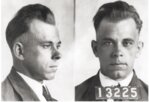




IT'S JULY 6th, 1934, the height of the Great Depression. Magnolia, then a fashionable summer colony, isreadying for another weekend of high society.
At the sprawling Oceanside Hotel, at the Hodgson Kennard Jewelry Store, Manager Charles Orcutt preparesto open for the season. Robert Hodgson, the owner’s son, arrives from the main branch in Boston to assist. After all, a major client arranged a private sale and the jeweler wanted to impress. The pair sort through an eye-popping array of gems and valuables received just the day before in anticipation of the buy.
Shortly after 10 a.m., two well-dressed men enter the jewelry store, and—even though it’s early in the day—Hodgson & Orcutt greet the potential customers.
But these men are not potential customers. Instead, the men flash automatic weapons, gag the two, and bind them together.
One culprit goes to the back room, where a local 16-year-old, Eddie Davis, is working his summer job polishing silver. Eddie ignores a tap-tap-tap on his back, thinking Orcutt is playing a prank. When he turns, a machine gun is aimed right at him.
Hearing the commotion, Orcutt’s wife and a hotel maid who live in an adjoining apartment, walk into the store. They find all three, then are bound, gagged and tossed to the floor with the others.
Three more bandits dash in, smashing display cases and grabbing everything of high value.
It’s a well-oiled operation. But there’s just one problem. Outside on Lexington Avenue, Mrs. Orcutt’s terrier, Heinie, is barking so incessantly it unnerves the machine gunner who threatens to spray the place with lead. The other robbers convince their partner not to shoot, and quicken their pace. In under five minutes, they stuff big canvas sacks, leave the victims on the floor, and screech off in two cars while Heinie barks away.
Police arrive in minutes, and a frantic search begins. The State Police in Topsfield are notified. So are detective bureaus in New York, Philadelphia, and Washington, DC.
As word spreads, details begin to paint a picture. Summer residents on Shore Road swear they saw a boat whiz recklessly away from Magnolia Pier. In Manchester, gas station attendants at Bailey’s Garage watch with dropped jaws as two racing sedans lean treacherously on two wheels, squealing as they round a corner and out of sight.
Back at the jewelry shop, police get descriptions of the robbers. Four dark complected men and one fair skinned man. The angry gunman had a “squashed” nose. All wore summer sports clothes, none wore masks. No fingerprints or clues were left behind. It’s a clean getaway.
Days later, the stolen jewels are assessed at over $325,000, equal to $6.3 million today. It’s noted the smoothness of the operation is similar to robbery teams out of the Providence, RI mob. It’s one of the largest heists in American history.
Abandoned cars are found in Rochester, NY, Lynn & Worcester. The first two leads go cold, but the dark green sedan in Worcester contains three revolvers and armor-plating. Police say it’s their vehicle.
Later, it was determined that in the hours before the robbery, at the Stage Fort Park Rest House in Gloucester, caretaker Sheldon Sudbay observed five men matching the robbers’ descriptions using the public washroom together.
Police believe the first two men to enter the store were “torpedoes” - gunmen hired by gangsters to aid sophisticated thieves. There’s no doubt these pros knew where to rob, when to rob and which jewels were most valuable.
All eyes turn to store manager Orcutt, who vows it’s not an inside job despite the bandits knowing intimate details of the location, recent jewel delivery and habits of the store.
Investigators believe the five are underground and avoiding “fencers” (middlemen who buy stolen goods to resell) in hopes that an intermediary will deliver a ransom from the insurance company in return for the jewels.
Then, a break. A week later, arrests are made in Providence—gangster types with long rap sheets. One witness immediately spots a gunman from a lineup, but refuses to go to court to make a positive ID. All suspects are eventually released.
Around Magnolia, folks can’t stop talking about the most exciting event in the village’s storied history. The 1930s are the height of robbery hysteria in America. Gangsters are as romanticized as reviled by the public and press. Six weeks before the Hodgson Kennard Heist, notorious criminal couple Bonnie & Clyde were killed in Louisiana. And just 12 days after the Magnolia heist, gangster and media darling John Dillinger is killed outside a theater in Chicago. (In fact, many speculate that Magnolia could’ve been the work of Dillinger’s Gang.)
By the end of the summer of 1934, all leads run dry. There’s no sign of the missing jewels. Or a middleman. Or a fencer or a snitch. The police drop the case.
Nearly 100 years later, The Amazing Magnolia Jewelry Heist remains unsolved.
Watch The Amazing Magnolia Jewelry Heist at this link: https://youtu.be/MZPiD13cjdA